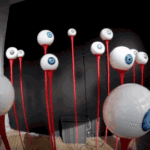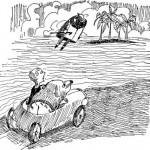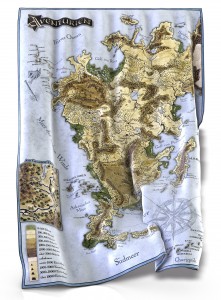Who didn't love computer RPG cloth maps?
Sometimes it is valuable to have something inside of a story that both the characters and participants can manipulate. Building an artifact that intersects with your main narrative thread is more common than you might think and very useful.
The first narrative artifact-type I’d like to deal with are narrative-centric artifacts. These are narrative fragments that are internal to a story. Essentially it is a piece of the story within the story, one that both the characters internal to the story and the participants external to the story can interact with. I’ve identified them in a number of works and formats and they are essential to enriching your text.
Why use narrative-centric artifacts?
The most prominent reason to use a narrative-centric artifact is to increase engagement of participants in the narrative. When the user interacts with an artifact together with the characters it deepens the universe and the characters.
Depending on the artifact, it may even lend a physical aspect to your universe, by giving your users something of your world that they can hold in their hands.
Where have narrative-centric artifacts been used?
I’ve put together a list of both general and specific examples of narrative-centric artifacts and how they are used to give this a little context. Hopefully it will also help build a better understanding of how to use narrative artifacts in your own work.
Video Games:
Perhaps the most common and easiest to explain narrative-centric artifact is the cloth map. In-game, your character and others would presumably have some sort of map to help them find their way around. By giving your audience a physical map that they too can consult with, it makes it feel like this universe matters enough to be mapped out with.
That solidity of cloth maps implies a whole spectrum of other elements: explorers, cartographers, illustrators, unexplored areas, and places beyond the map. Very effective.
General Entertainment:
TV, video games and movies all make use of physical tie-ins. While action figures don’t count, the existence of weapons from a narrative is fairly commonplace. Once again, this is all about deepening the world for participants. With this in mind, the closer to real the weapon is, the more effective an artifact.
TV shows, especially the USA Network’s shows, also do promotion through various media formats, most notably blogs, done in the voices of their characters. They were one of the first to allow participants to receive texts from in-narrative personalities. Character-audience participation that doesn’t break the fourth wall is often a narrative-centric artifact.
Journalism:
I found it surprisingly difficult to tie down examples of narrative-centric artifacts in journalism. I know they exist and have seen them, but I just cannot find them at the moment. I suppose data journalism is a good example, when the same data is known by the subjects of a piece and is available to the readers.
Perhaps the highest profile case of narrative-centric artifacts in journalism is WikiLeaks. This is a major case in which the primary topic of many reports is a document or documents that are available as easily to the reader as the reporter. For journalism, since you are already dealing in reality, narrative-centric artifacts help engage and educate readers while giving rise to a more intelligent discussion.
In some cases, infographics may also qualify.
Web-comics:
There may be other ways that web-comic creators use narrative-centric artifacts than Twitter but, from what I’ve seen, none are more effective. Participants follow characters’ Twitter accounts in droves. Two excellent examples are the casts of the Dresden Codak and Questionable Content (QC). In both cases the creators of the comics build mini-narratives into their characters’ Twitter streams, including interactions with other characters from the same universe.
Overall, in-character twittering seems to effectively increase draw (short-format narratives that exist continually inside the universe of the primary narrative allow for more frequent participation) and engagement. Besides increasing the web-comics’ reality, the tweets are also effective promotion, allowing fans to readily and frequently promote content through re-tweets.
Also, people just seem to really like following fictional characters on Twitter.
This blog:
Honestly, I don’t really use narrative-centric artifacts on this blog because I rarely deal in characters, fiction or factual. Except myself. I could argue that my Amps are narrative-centric since they present an artifact (someone else’s article) and my discussion around it.
Styled text and headers are also types of narrative-centric artifacts, in that they intersect with my narrative and are used by both participants and the author/character. However, they don’t really enlarge my content, so while they are great SEO, they are poor artifacts. I wonder how to enhance them to be more effective? Ideas?
Depending on how central linked content is to a post, links might also present narrative-centric artifacts. This is one of the reasons I really like playing with Apture. It doesn’t always work, but when it does it allows me to embed a fragment of other sites inside my own. I think that’s probably the closest to narrative-centric artifacts that I have on this blog.
Building your universe with narrative-centric artifacts:
Besides the various examples here the most common and easily executed way to place narrative-centric artifacts in a universe is through fictional documentation. Maps are the most common example, but creators can easily go beyond that. Video games and transmedia experiences commonly provide descriptions of ships, weapon specifications and other fictional texts that come from the story and with which both the participants and the characters interact.
Later: Narrative-parallel artifacts.
Before: What are narrative artifacts?
Related articles
- Artifacts: building dimension into your narrative [Narrative Artifacts: 1 of 4] (hacktext.com)
- What is a text and how do I hack it? (hacktext.com)
- Narrative Medicine and Blood Pressure (33charts.com)
- Thought police? Darpa wants to know how stories influence human mind, actions (networkworld.com)






























